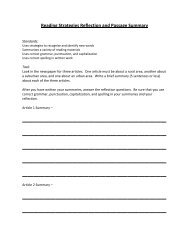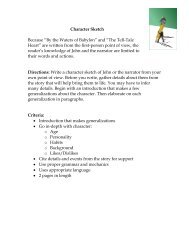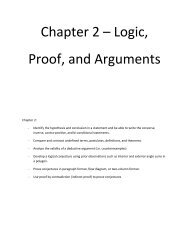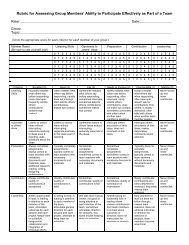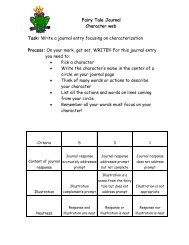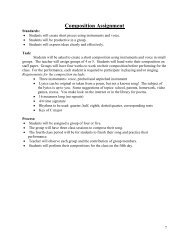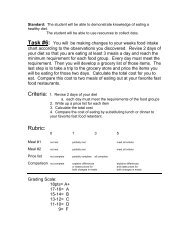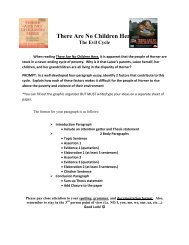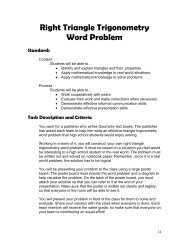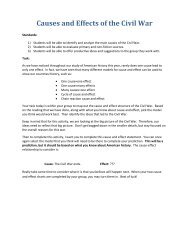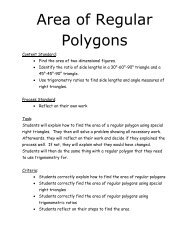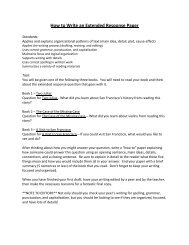Persuasive speech evaluation: Defining characteristics
Persuasive speech evaluation: Defining characteristics
Persuasive speech evaluation: Defining characteristics
Create successful ePaper yourself
Turn your PDF publications into a flip-book with our unique Google optimized e-Paper software.
Task #3<br />
<strong>Persuasive</strong> Speech Evaluation: <strong>Defining</strong> Characteristics<br />
Content Standards:<br />
1. TSWBAT identify the defining <strong>characteristics</strong> of a persuasive piece.<br />
Task:<br />
Overview:<br />
- The teacher will read a persuasive <strong>speech</strong> aloud to the class.<br />
- The persuasive <strong>speech</strong> can come from a variety of resources, but it is suggested to<br />
use a famous <strong>speech</strong> that the students can relate to or identify from topics covered<br />
in other content areas. (United Streaming is a good resource for <strong>speech</strong>es so the<br />
students can see it as well.)<br />
Introductory Activity:<br />
1. Explain to the students that a persuasive piece can also come in the form of a<br />
<strong>speech</strong>.<br />
2. Have the students discuss in their groups the defining <strong>characteristics</strong> of a<br />
persuasive piece in their groups.<br />
3. Have grand conversation reviewing the <strong>characteristics</strong>.<br />
4. Ask if they think those <strong>characteristics</strong> should still be included in a persuasive<br />
<strong>speech</strong>. (Answer: Yes, but discuss why).<br />
5. Tell the students they will be evaluating the <strong>speech</strong> based on whether or not it has<br />
all the defining <strong>characteristics</strong> of a persuasive <strong>speech</strong>.<br />
Whole Group Activity:<br />
1. Model the activity using a good persuasive <strong>speech</strong> with all of the defining<br />
<strong>characteristics</strong>. (procedures of activity listed below)<br />
2. Discu<br />
3. Pause to discuss when students identify one of <strong>characteristics</strong> (can put thumbs up<br />
when hear one).<br />
Individual Practice:<br />
1. Have students create a t-chart in their writing folder. On the left side, list the<br />
defining <strong>characteristics</strong> with space between each.<br />
2. As the <strong>speech</strong> is given, write a quote or note describing how the speaker<br />
incorporated a specific defining characteristic. (written on the left side of T-chart)<br />
3. At end of <strong>speech</strong>, have students write an explanation the <strong>speech</strong> is a good<br />
persuasive piece. (Should incorporate the defining <strong>characteristics</strong> heard and an<br />
example of when it was heard).<br />
Conclusion Activity:<br />
1. Have students discuss with group their explanations.<br />
2. Have a grand conversation discussing if the <strong>speech</strong> is an example of a good<br />
persuasive piece and why.
Criteria:<br />
1. On the left side T-chart, the students should have an accurate list of the defining<br />
<strong>characteristics</strong> they heard in the <strong>speech</strong>.<br />
2. Each characteristic heard should include an example of how the speaker<br />
incorporated that characteristic.<br />
3. Students’ explanation of why the <strong>speech</strong> is or is not a good persuasive piece is<br />
based on the defining <strong>characteristics</strong> they heard in the <strong>speech</strong>.<br />
Rubric:<br />
(Use the T-Chart to complete this rubric).<br />
List of<br />
<strong>Defining</strong><br />
Characteristics<br />
Examples of<br />
<strong>Defining</strong><br />
Characteristics<br />
Good/Bad<br />
<strong>Persuasive</strong><br />
Piece<br />
Explanations<br />
0 points 1 point 2 points 3 points Total<br />
List of defining List of defining Accurate and<br />
<strong>characteristics</strong> heard <strong>characteristics</strong> heard complete list of<br />
in the <strong>speech</strong> is in the <strong>speech</strong> is defining<br />
somewhat accurate mostly accurate and <strong>characteristics</strong><br />
and complete<br />
complete.<br />
heard in the<br />
There is no<br />
list of<br />
defining<br />
<strong>characteristics</strong><br />
heard in the<br />
<strong>speech</strong>.<br />
There are no<br />
examples of<br />
defining<br />
<strong>characteristics</strong><br />
heard in<br />
<strong>speech</strong>.<br />
There is no<br />
explanation of<br />
why book is a<br />
good or bad<br />
persuasive<br />
piece.<br />
Includes very few<br />
examples of defining<br />
<strong>characteristics</strong> heard<br />
in the <strong>speech</strong>.<br />
Weak explanation:<br />
does not include the<br />
defining<br />
<strong>characteristics</strong> heard<br />
or not heard.<br />
Includes some<br />
examples of defining<br />
<strong>characteristics</strong> heard<br />
in the <strong>speech</strong>.<br />
Somewhat strong<br />
explanation: includes<br />
some of the defining<br />
<strong>characteristics</strong> heard<br />
or not heard.<br />
<strong>speech</strong>. /3<br />
Includes example<br />
of all defining<br />
<strong>characteristics</strong><br />
heard in the<br />
<strong>speech</strong>.<br />
x2 /6<br />
Strong<br />
explanation:<br />
includes all the<br />
defining<br />
<strong>characteristics</strong><br />
heard or not heard. x3 /9<br />
Total /18<br />
Comments:______________________________________________________________<br />
________________________________________________________________________



